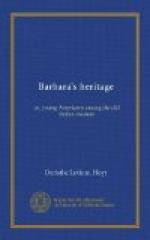“We cannot doubt the dramatic power of Tintoretto, can we?” asked Mr. Sumner, with a suppressed twinkle of the eye. “What shall we look for next? Let us ascend this beautiful staircase. Now look at this Visitation. Is it not truly fine, charming in composition, graceful in action, agreeable in color, and true and noble in expression?”
All agreed most eagerly with Mr. Sumner’s opinion of the picture. Then, turning, Bettina caught sight of an Annunciation, and cried:—
“How thoroughly exquisite! See those lovely angels tumbling over each other in their haste to tell the news to Mary! How brilliant! Surely Tintoretto did not paint this!”
“No. This is by Titian; and it is one of his most happy religious pictures too. I thought of it as we were coming, and am glad to have you see it. The whole expression is admirable; and the fulness of life and joy—the jubilation—is perfect. You can in no way more vividly feel the difference between fourteenth-century painting in Florence, and the sixteenth-century or High Renaissance work in Venice, than by recalling Fra Angelico’s sweet, calm, staid Annunciations, and contrasting them with this one.”
“But why do I feel that, after all, I love Fra Angelico’s better, and should care to look at them oftener?” rather timidly asked Barbara.
“I think,” replied Mr. Sumner, after a little pause, “that it is because, in them, the spiritual expression dominates the physical. We recognize the fact that the artist has not the power to picture all that he desires to express. His art language is weak; therefore there is something left unsaid, and this compels our attention. We wish to understand his full meaning, so come to his pictures again and again.
“It is this quality of the fourteenth-century painting that impelled the Pre-Raphaelites, German and English, to discard the chief motif of the High Renaissance, which was to picture everything in its outward perfection. They thought that this very perfection of artistic expression led to the elimination of spiritual feeling.”
“But how can artists go back now and paint as those did five centuries ago?” queried Malcom. “Of course, if they study methods of the present day, they must know all the principles underlying a true and artistic representation—and it would be wrong not to practise them.”
“You have at once found the weak point in the Pre-Raphaelites’ principle of work, Malcom. It is forced and artificial to do that in the nineteenth century which was natural and charming in the fourteenth. That which our artists of to-day must do if they desire any reform is to so fill themselves with the comprehension of spiritual things—so strive to understand the hidden beauty and harmony and truth of nature—that their works may be revelations to those who do not see so clearly as do they. To do this perfectly they must ever, in my opinion, give more thought to the thing to be expressed than to the manner of its expression; yet they must render this expression as perfectly as the present conditions allow. But I think I have talked before of just this thing. And we must turn again to Tintoretto.”




